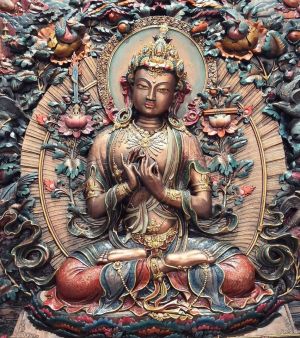Five Dhyani Buddhas – Embodiment of the Five Aggregates
(Top to bottom): Buddha Shakyamuni, Buddha Ratnasambhava, Buddha Amoghasiddhi, Buddha Akshobhya, Buddha Amitabha, Buddha Vairocana, Dorje Shugden and Kache Marpo.
Deity: Five Dhyani Buddhas (English)
Alternate names: Pancha Tathagata (Sanskrit)
The term ‘Five Dhyani Buddhas’ was first coined in the early 19th Century by Brian Hodgson, a British resident in Nepal. However, the original Sanskrit term for the group of enlightened beings is ‘Pancha Tathagata’, which literally means ‘Five Buddhas’.
It is believed that the Five Dhyani Buddhas arose due to the development of Tantric Buddhist teachings and are associated with the doctrine of Trikaya or the Three Bodies of a fully enlightened Buddha. Earliest mentions of the Five Dhyani Buddhas occur in the Vajrasamgraha Tantra and Vajrasekhara Sutra. They are considered to be the embodiment of the five aggregates (form, feeling, discrimination, mental formation and consciousness) in their purified form.
Thus, all other Buddhas fall under one of the Five Dhyani Buddha archetypes known collectively as the Five Families. Each Dhyani Buddha represents an aggregate, an associated colour, a cardinal direction and a direct counter to one five major delusions, along with a host of other attributes. These are explained below:
Buddha Ratnasambhava (Tibetan: Rinchen Jungne): yellow in colour, represents feeling, resides in the southern region and counters both pride and miserliness.
Buddha Akshobhya (Tibetan: Mitrugpa): blue in colour, represents consciousness, resides in the eastern region and counters hatred.
Buddha Vairocana (Tibetan: Berotsana): white in colour, represents form, resides in the central region and counters ignorance.
Buddha Amitabha (Tibetan: Opagme): red in colour, represents discrimination, resides in the western region and counters desire and lust.
Buddha Amoghasiddhi (Tibetan: Donyo Drubpa): green in colour, represents mental formation, resides in the northern region and counters jealousy and fear.
Deity: Buddha Shakyamuni (Sanskrit)
Alternate Names: Sangye Shakya Tubpa (Tibetan)
Buddha Shakyamuni is the historical Buddha who founded Buddhism in ancient India about 2,500 years ago. After an exhaustive search, he finally attained perfect and complete enlightenment under the Bodhi tree in Bodhgaya. His teachings became the basis for the Buddhist faith and he proclaimed that he is not the only one who achieved his state and revealed that there are other fully awakened beings that we can rely on.
All of the Buddha’s teachings are based on the four Noble Truths, which he established in his first sermon to explain the basis of our existence in his first teaching after gaining enlightenment. He is depicted sitting in the Vajra position with his legs in the pose of full meditation. His body is said to bear all the 112 marks of a fully enlightened Buddha according to the ancient Indian belief of a Chakravartin or Universal Monarch. Buddha Shakyamuni is normally depicted with the Bhumisparsa mudra or the earth touching mudra with his right hand and the other hand cradling a begging bowl.
Kache Marpo is the special attendant within the entourage of Dorje Shugden. He is believed to be the emanation of the Buddha Hayagriva (Tibetan: Tamdrin) and thus an enlightened Protector in his own right. In fact, he is widely regarded to be originally part of the Seven Blazing Brothers of Tsui Marpo. He is known also by the name ‘Chokyong Tsengo’ or the ‘Dharma Protector Wild Tsen’, which refers to a class of warrior-like beings called Tsen. Thus, he is depicted in the wrathful aspect of a Tsen, wearing all the warrior-like accoutrements while bearing the fearsome demeanour of his kind. He is also known to take possession of trained oracles in order to give oracular pronouncements. Usually, the peaceful aspect by the name of Yumar Gyalchen takes possession of the oracle and an example of such an oracle would be the Panglung oracle.
Deity: Dorje Shugden (Tibetan)
Alternate name: Vajra Rudra (Sanskrit)
Dorje Shugden is an emanation of the Buddha of Wisdom, Manjushri. He took the form of a Dharma Protector in order to safeguard the Buddha’s teachings, especially the important teachings on the Middle Way view. Reminiscent of Manjushri’s form, Dorje Shugden carries a meandering sword and rides a snowlion that represents the fearlessness of a fully enlightened Buddha. Furthermore, he carries a jewel-spitting mongoose and a vajra hook to symbolise that he has the tremendous ability to bestow wealth and resources. He has great strength to overcome obstacles of the body, speech and mind, and create suitable conditions for our spiritual practice to flourish.
